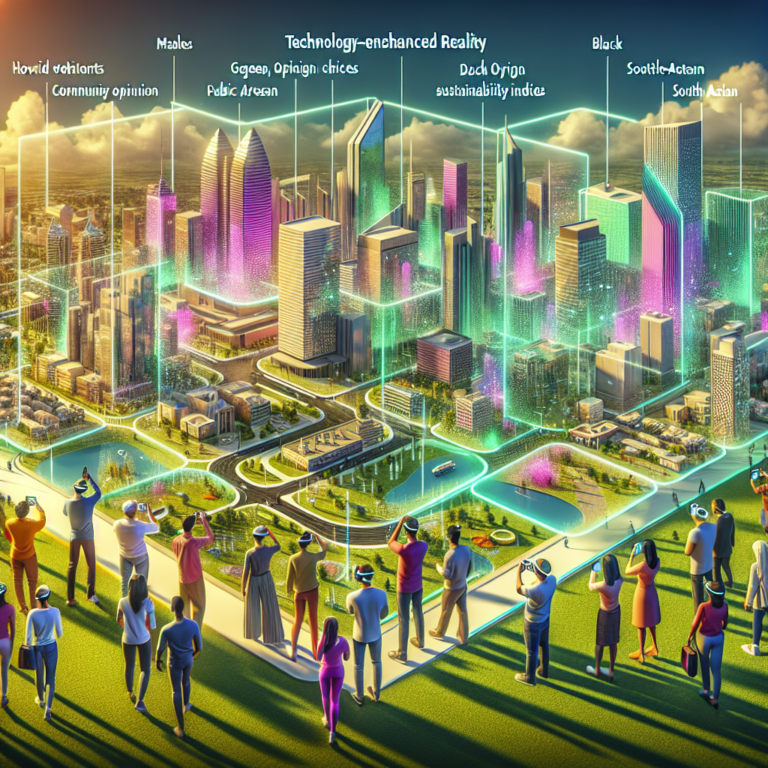Envisioning a Future: The Impact of Augmented Reality on Urban Planning and Architecture 🌆
Introduction
In a world that’s rapidly evolving, technology is taking the reins, transforming various industries and our daily lives. Among the innovations that stand out, Augmented Reality (AR) is proving to be a game-changer, especially in urban planning and architecture. But what does this mean for our cities and the way we design our living spaces? Let’s delve into how AR is reshaping the landscape of architecture and urban development.
Understanding Augmented Reality
Before exploring its implications, it’s essential to grasp what augmented reality truly is. Unlike virtual reality, which immerses users in a completely digital environment, AR overlays digital information onto the real world. This capability enables architects and urban planners to visualize infrastructure, buildings, and public spaces in a more interactive and intuitive way. 🌍
The Revolution in Visualization
One of the most significant advantages AR brings to urban planning is the ability to visualize projects before they break ground. Imagine walking through a proposed park or a new residential complex before construction even begins. With AR, this becomes a reality.
- Interactive Models: AR technology allows stakeholders to experience three-dimensional models of buildings, giving them a sense of scale and functionality.
- Real-Time Changes: Architects can make instant adjustments based on feedback from clients or the community, enhancing collaboration and ensuring all voices are heard.
- Contextual Understanding: By overlaying designs onto existing landscapes, planners can understand how the new structures will fit into the current environment.
Engaging the Community through AR
Urban planning is not just about structures; it’s about the people who inhabit those spaces. Engaging the community is vital for successful development. AR facilitates this engagement by making the design process more inclusive and interactive.
Participatory Planning with AR
The traditional methods of public consultation often leave community members feeling disconnected. With AR, residents can visualize changes to their neighborhoods in real-time through their smartphones or AR glasses. This promotes a sense of ownership and belonging.
- Community Feedback: Citizens can provide immediate input on designs, leading to more community-focused urban spaces.
- Educational Opportunities: Engaging the public with AR can educate them about sustainable practices and urban challenges.
- Enhanced Transparency: By showcasing designs through AR, planners can ensure that residents clearly understand project intentions and goals.
Transforming the Design Process
The architectural design process is complex, involving numerous stakeholders and iterations. AR streamlines this process, making it more efficient and effective.
Streamlined Collaboration
When multiple teams are involved in a project, communication can become convoluted. AR bridges this gap by offering a unified platform for all parties to engage with the same digital model, reducing misunderstandings and fostering better collaboration among architects, engineers, and urban planners.
- Instant Updates: Team members can quickly access the latest designs and revisions, ensuring everyone is on the same page.
- Visual Learning: Instead of relying solely on blueprints, team members can visually interact with the project, enhancing comprehension and creativity.
- Remote Collaboration: AR enables team members from different locations to participate in the design process seamlessly, breaking geographical barriers.
Designing for Sustainability
Sustainability is at the forefront of urban planning and architecture. Augmented reality can help architects design greener, more sustainable buildings that minimize environmental impact.
Evaluating Environmental Impact
Using AR, architects can simulate the environmental effects of their designs in real-time, allowing them to make informed decisions about materials, placement, and energy efficiency.
- Sunlight and Shadow Modeling: AR tools can help designers analyze how sunlight will interact with their buildings, optimizing energy use and minimizing heat loss.
- Resource Management: Planners can visualize and assess the impact of landscaping choices on water usage, paving the way for greener cities.
- Waste Reduction: By foreseeing potential challenges through AR simulations, architects can minimize waste during construction.
The Future Awaits: Real-World Applications
Some urban areas are already harnessing the power of AR to create smarter, more interactive environments. Cities like New York, San Francisco, and Amsterdam are experimenting with AR tools to enhance their urban planning processes.
Case Studies of AR in Action
- Smart Cities: Some cities are integrating AR into their existing infrastructure, allowing citizens to interact with real-time data about their environment.
- Architectural Firms: Leading design firms have adopted AR for client presentations, providing immersive experiences that engage clients in unprecedented ways.
- Urban Revitalization Projects: Communities undergoing revitalization can utilize AR to visualize new potential, fostering excitement and support among residents.
Conclusion: The Potential of AR in Shaping Our Cities
As we look toward the future, the potential of augmented reality to transform urban planning and architecture is immense. By enhancing visualization, fostering community engagement, streamlining collaboration, and paving the way for sustainable practices, AR is poised to redefine how we build and interact with our spaces. The cities of tomorrow are not just being designed; they are being envisioned through a lens of innovation and engagement, making our urban landscapes more dynamic and inclusive than ever before. 🌟




0 Comments